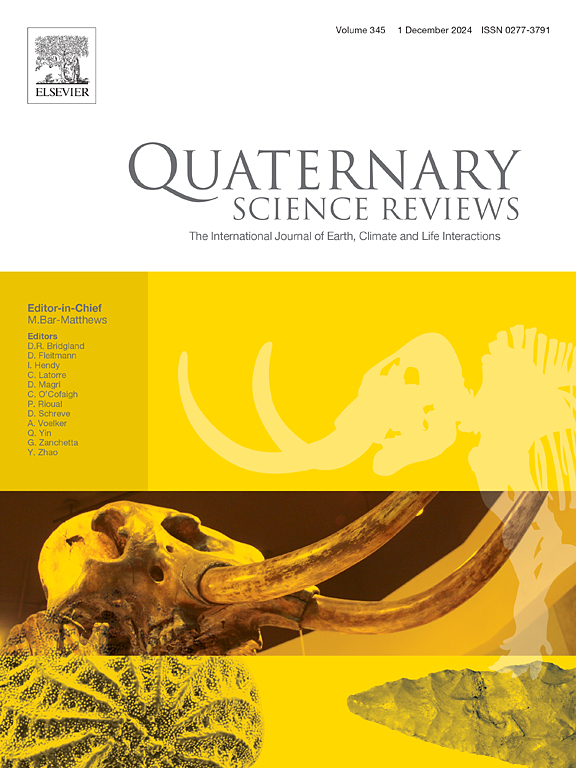Flood and earthquake records over the past 2000 years revealed by varved lake sediments from Lake Xinluhai, southeastern Tibetan Plateau
IF 3.2
1区 地球科学
Q1 GEOGRAPHY, PHYSICAL
引用次数: 0
Abstract
The southeastern margin of the Tibetan Plateau experiences frequent natural disasters, yet long-term records are scarce for risk assessment. We established a 2000-year varve chronology from Lake Xinluhai using a 1150 cm sediment core, combining varve counting and AMS 14C dating. A multi-proxy analysis, including grain-size, total organic carbon (TOC), charcoal and pollen concentrations, and μ-XRF surface scanning of elemental composition in laminae and turbidite layers, revealed two distinct types of turbidites: (1) Flood-induced turbidites, which exhibit graded bedding with coarse sand at the base transitioning upward to fine silt, capped by a clay-rich layer. At the turbidite base, these layers show a sharp increase in D50, D90, TOC, charcoal, and pollen concentrations, along with the poorest sorting. Upward, these parameters decrease, while sorting improves, reflecting a systematic hydrodynamic sorting process. (2) Earthquake-triggered turbidite contains mixed bedrock fragments and clay, with erratic grain-sizes, poor sorting, and slightly elevated TOC, but without notable changes in charcoal or pollen assemblages relative to background sediments. Our findings indicate that ten turbidites were deposited by extreme rainfall-induced floods (recurrence interval: 73–279 years; last event: 1796–1806 CE), while one turbidite was triggered by a slope collapse associated with a Ms ≥ 6.0 earthquake on the Manigange segment of the Ganzi-Yushu Fault during 842–867 CE. Given that over 200 years have passed since the last flood, the probability of future flooding is high. This study provides a scientific basis for long-term natural hazard assessment in the southeastern Tibetan Plateau.
青藏高原东南部新鹿海湖湖泊沉积物2000年来的洪水和地震记录
青藏高原东南缘自然灾害频发,但缺乏长期灾害风险评估记录。利用1150 cm沉积物岩心,结合阀计数和AMS 14C测年,建立了新鹿海湖2000年的阀年代学。通过颗粒粒度、总有机碳(TOC)、碳和花粉浓度、μ-XRF表面元素组成等多指标分析,揭示了两种不同类型的浊积岩:(1)洪水浊积岩呈渐变层理,基底为粗砂,向上过渡为细粉砂,上覆富粘土层;在浊积岩底部,这些层的D50、D90、TOC、木炭和花粉浓度急剧增加,分选最差。向上,这些参数减小,分选提高,反映了系统的水动力分选过程。(2)地震触发浊积岩中基岩碎片与粘土混合,粒度不稳定,分选差,TOC含量略有升高,但相对于背景沉积物,木炭和花粉组合变化不明显。研究结果表明:10种浊积物是由极端降雨引起的洪水沉积的(复发周期:73 ~ 279年;最后一次活动为1796-1806 CE),而一次浊积岩则是在842-867 CE期间由甘孜—玉树断裂带马尼格段发生的6.0级以上地震引起的斜坡崩塌引发的。鉴于上次洪水已经过去了200多年,未来发生洪水的可能性很高。本研究为青藏高原东南部长期自然灾害评价提供了科学依据。
本文章由计算机程序翻译,如有差异,请以英文原文为准。
求助全文
约1分钟内获得全文
求助全文
来源期刊

Quaternary Science Reviews
地学-地球科学综合
CiteScore
7.50
自引率
15.00%
发文量
388
审稿时长
3 months
期刊介绍:
Quaternary Science Reviews caters for all aspects of Quaternary science, and includes, for example, geology, geomorphology, geography, archaeology, soil science, palaeobotany, palaeontology, palaeoclimatology and the full range of applicable dating methods. The dividing line between what constitutes the review paper and one which contains new original data is not easy to establish, so QSR also publishes papers with new data especially if these perform a review function. All the Quaternary sciences are changing rapidly and subject to re-evaluation as the pace of discovery quickens; thus the diverse but comprehensive role of Quaternary Science Reviews keeps readers abreast of the wider issues relating to new developments in the field.
 求助内容:
求助内容: 应助结果提醒方式:
应助结果提醒方式:


